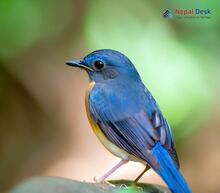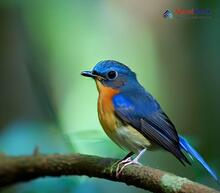Discovering the Enigmatic World of Cyornis in Nepal: Classification, Features, and Evolutionary Relationships
Nestled within the vibrant biodiversity of Nepal, the Cyornis genus has captivated naturalists and bird enthusiasts alike. This group of Old World flycatchers not only boasts unique beauty but also reveals fascinating insights into their classification, common features, evolutionary relationships, and nomenclature. Here, we'll take flight with these captivating birds, exploring the depths of their taxonomy and characteristics to better understand their place in nature.
Unraveling the Taxonomy of Cyornis: Classification and Nomenclature
Belonging to the family Muscicapidae, Cyornis encompasses a diverse array of species that encompass a wide geographic range across Asia. With intricate patterns and vibrant hues adorning their plumage, these enigmatic birds bear distinctive morphological features that distinguish them from other related genera.
The nomenclature of Cyornis stems from Greek roots - 'cyon' meaning dog and 'ornis' referring to a bird. While one might wonder about the connection between dogs and this avian genus, this curious name alludes to the strong territorial behavior exhibited by these birds towards intruders.
A Closer Look at Common Features
Despite varying appearances among species within the genus Cyornis, there are several commonalities shared by these fascinating birds. Most species display sexually dimorphic plumage – males typically flaunt more vivid colors while females exhibit subtler hues. Furthermore, Cyornis birds possess stout bills adapted for catching insects mid-flight; a testament to their exceptional hunting prowess.
Beyond physical traits, Cyornis species share similar ecological preferences typically found in forested habitats such as thickets, undergrowth or canopy layers. In addition to this affinity for wooded environments, many species are partial migrants within their home ranges – demonstrating seasonal adaptations to food availability and breeding conditions.
Decoding Evolutionary Relationships: Uncovering the Cyornis Tree of Life
Understanding the evolutionary relationships within the genus Cyornis is a challenging endeavor. To shed light on their phylogenetic ties, scientists turn to molecular genetics as a means to unravel their lineage. Utilizing DNA analysis techniques such as mitochondrial genome sequencing, researchers can construct a genetic “family tree” for Cyornis species. This cutting-edge approach aids in identifying key evolutionary events that have shaped the diversity of this genus through time.
Remarkably, such DNA-based studies have revealed unexpected similarities between seemingly distant Cyornis species as well as highlighting unique traits shared among closely-related taxa. These discoveries serve to deepen our understanding of how these remarkable birds evolved and adapted to various environments across their expansive range.
As our exploration into the world of Cyornis in Nepal comes to a close, we hope that you've gained an appreciation for these remarkable birds and their intricate classification, common features, and evolutionary relationships. Delving into their captivating existence showcases not only the rich biodiversity found within Nepal but also the wonder that lies within each feathered marvel that graces our skies.




